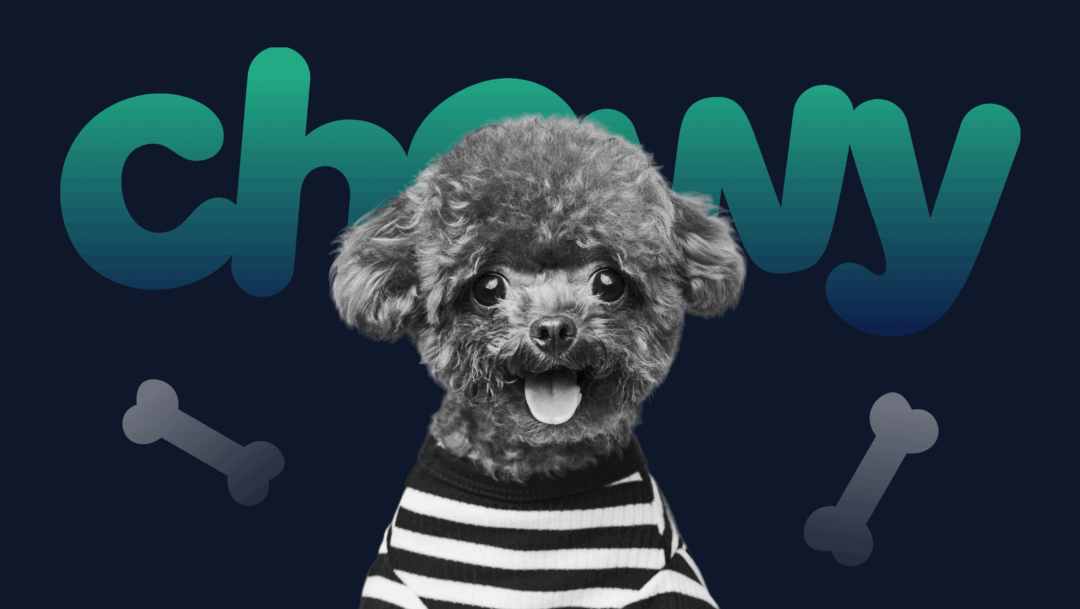How do you get customers to pick your $300 cooler when there’s a $40 one right next to it on the shelf? And how do you ensure those customers return—and recommend your brand to their friends?
It all comes down to one thing.
Science calls it the psychology of connection.
In marketing, we call it brand association.
Statistics back this up: 94% of consumers say they recommend brands they feel emotionally connected to.
People don’t just buy features–they buy feelings, stories, and symbols. These create emotional shortcuts that make it easy for their brains to say, “Yes, this is the one,” even when the competition looks the same on paper.
That’s brand association in action.
It’s the silent advantage behind why someone chooses your brand over the next.
But what exactly is brand association in marketing—and how can you use it to grow your business?
Want the big picture at a glance? Here’s a visual breakdown of brand association—what it is, how it works, and why it matters for your brand:
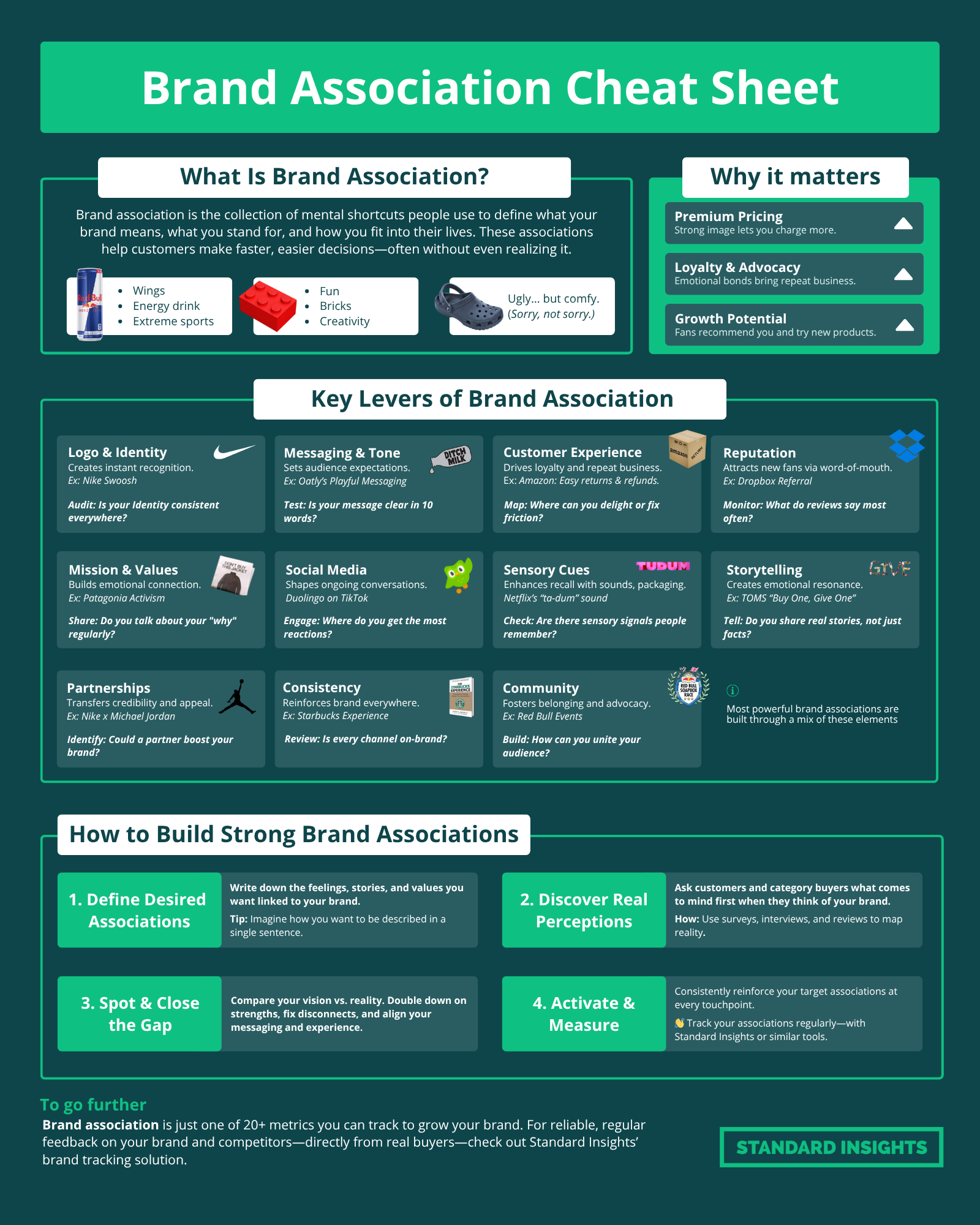
What Is Brand Association?
Whenever someone thinks of your brand, their brain instantly pulls up a mix of thoughts, feelings, and memories.
Brand association is the collection of mental shortcuts people use to define what your brand means, what you stand for, and how you fit into their lives. These associations help customers make faster, easier decisions—often without even realizing it.
- Red Bull: Energy drink, wings, extreme sports
- Lego: Bricks, creativity, fun
- Crocs: Ugly… but comfy. (Sorry, not sorry.)
- Yeti: Outdoors, ruggedness, performance
These associations stick.
Every touchpoint shapes these associations: your packaging, ads, product design, voice, and even word-of-mouth.
Strong, positive associations build emotional bonds and nudge customers to think, “This is the one for me,” Removing the usual friction from the buying process.
They make your brand easier to recall and harder to ignore. That’s essentially what drives true brand loyalty and sales.
Examples of Strong Positive Associations
Strong brand associations work well because they trigger powerful emotions—like desire, belonging, safety, or a sense of quality—that make brands unforgettable.
Most of us don’t even realize how much these associations influence our decisions.
Brand Association Example: Trust and Quality
One thing that instantly draws customers in is the perception of reliability—consistent performance you can count on.
It’s quality you can feel, not just see.
YETI knows how to express this.
They sell premium coolers for outdoor lovers, but what they really offer is the promise of performance in the harshest conditions.
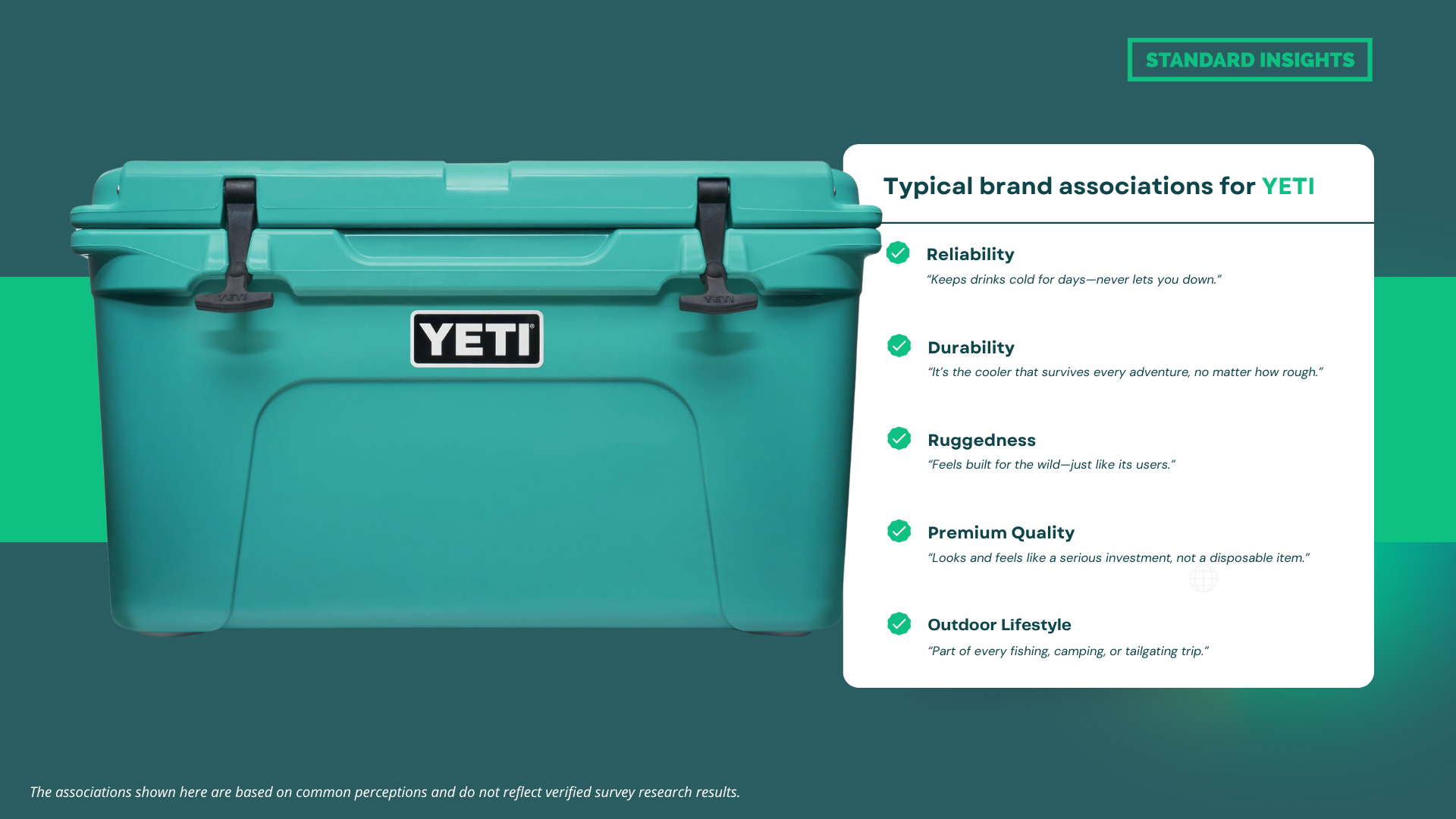
YETI quickly earned a reputation for extreme durability—becoming more than just a cooler brand. People see it as gear that takes a beating and still delivers.
Even non-campers and fishers buy into the rugged promise, making YETI a popular gift and trusted choice far beyond its niche.
“People, in the long run, want to feel part of a tribe or feel like they’re contributing alongside like-minded people.”
— Scott Ballew, YETI’s Head of Content
Brand Association as a Tool for Identity and Self-Expression
Brands that align with a customer’s self-image naturally become tools for self-expression. People gravitate toward brands that reflect who they are—or who they aspire to be.
Take Harley-Davidson. They’re not just selling motorcycles—they’re selling rebellion, freedom, and individuality. Riders identify with the brand as a lifestyle. It’s not just what they ride; it’s who they are.
Some fans even tattoo the Harley-Davidson logo on their skin. How many people do that with your brand?
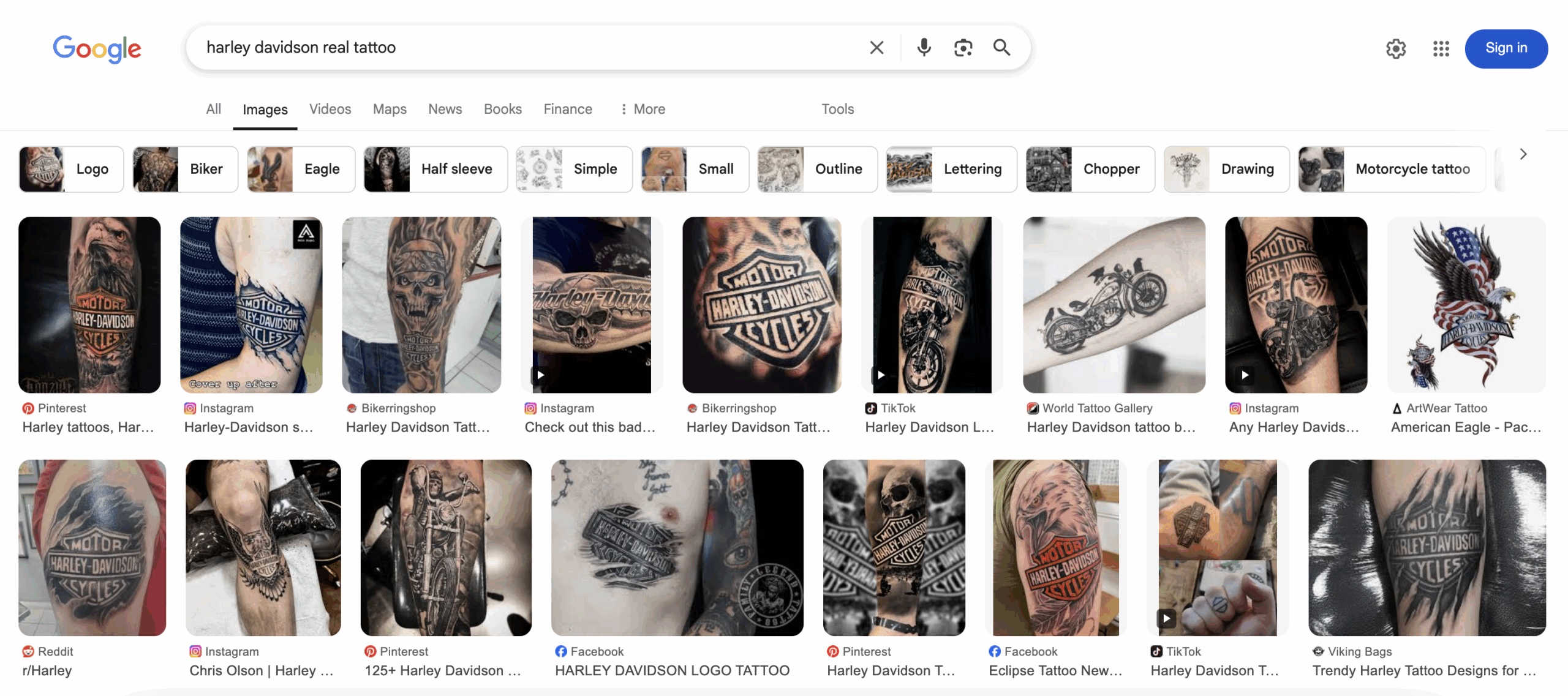
As you can see from these brand association examples, the idea is to identify your ideal audience and find out the emotional cues they respond to—and bring them to life in creative, memorable ways.
You already have the tools to shape perception. These are your brand association elements.
Elements of Brand Association in Marketing
You have many levers to shape what customers associate with your brand. Key elements include:
| Element | What It Is | How It Adds Value | Example from Cheat Sheet |
|---|---|---|---|
| Logo & Identity | Logo, colors, tagline | Creates instant recognition, builds trust | Nike Swoosh |
| Messaging & Tone | Communication style, slogans | Sets expectations, appeals to target audience | Oatly’s playful messaging |
| Customer Experience | Service quality, user interactions | Drives loyalty, encourages repeat business | Amazon: Easy returns & refunds |
| Reputation | Customer reviews, public perception | Attracts new customers, lowers acquisition costs | Dropbox referral |
| Mission & Values | Core beliefs, ethical stance | Builds emotional connection, differentiates | Patagonia activism |
| Social Media Presence | Platforms, campaigns, engagement | Expands reach, shapes ongoing conversations | Duolingo on TikTok |
| Sensory Elements | Sounds, scents, packaging feel | Triggers memory, enhances recall | Netflix’s “ta-dum” sound |
| Storytelling | Brand stories, heritage | Builds emotional resonance, creates meaning | TOMS “Buy One, Give One” |
| Partnerships & Endorsements | Celebrity, influencer, brand alliances | Transfers credibility and appeal | Nike & Michael Jordan (Air Jordan) |
| Consistency | Unified experience across touchpoints | Reinforces associations, avoids confusion | Starbucks experience |
| Community | Activism, local relevance, events | Deepens loyalty, fosters community | Red Bull events |
These elements aren’t just for brand association—they’re also at the core of your brand positioning. Think of them as your starting points for building strong associations. The most powerful brand associations are created through a mix of these elements, working together consistently.
But how do these associations translate into real value for your company?
Why Brand Association in Marketing Matters More Than You Think
It contributes to your brand equity—the value your brand holds in the minds of customers.
Brand equity influences everything: whether they choose you over a competitor, how they interpret your ads, respond to promotions, or embrace something new from you.
Strong, positive brand associations build strong brand equity, which gives you a clear competitive edge.
Here’s how it pays off:
1. Current Performance and Profitability
A strong brand image lets you charge higher prices and attract more loyal buyers.
When customers trust your brand and feel a genuine connection, they become less price-sensitive and more likely to pay a premium. It’s why Yeti can charge $200 for a cooler and why luxury brands maintain margins of 80% and more.
Your marketing efforts also land better—people are already inclined to see your brand positively, so they’re more likely to pay attention, engage, and take action.
2. Longevity of Profits
When your brand associations are strong, customers stick around, making your company more resilient to competitors’ strategies and market fluctuations. Loyal customers are less likely to be swayed by rivals or shifts in the market.
Take Gymshark. By aligning with fitness influencers and everyday athletes—not just celebrities—it’s built a loyal community. Even as new activewear brands pop up, fans stick around because they feel part of something bigger.
This foundation of loyalty supports steady, long-term profits—even when trends shift.
3. Growth Potential
Strong brand associations can unlock new opportunities like licensing deals, positive word-of-mouth, and successful product line extensions.
Look at Liquid Death—a brand that turned canned water into a lifestyle statement. Liquid Death’s bold, irreverent approach has allowed it to expand from water into iced tea, merch, and even branded events, with fans embracing each new move.
Customers are more willing to try new offerings from brands they trust and are more likely to recommend those brands to others.
How to Build a Strong Brand Association
Step One: Define Who You Want to Be
How do you want people to perceive and describe your brand? What emotions should it spark—excitement, trust, nostalgia?
Go wild and write down anything that comes to mind: emotions, colors, celebrities, places, even activities. Start with our one-page Brand Association Table. (No email required.)
Then, step into your ideal customer’s shoes. What do they care about? What emotional triggers resonate with them? You want to build associations that connect deeply with what matters most to your audience.
Step Two: Know What People Actually Associate with Your Brand
Next, find out what your brand really means to people.
What comes to mind when they hear your name?
Get honest feedback—brand tracking surveys and interviews can reveal both what people think and why.
Once you have this feedback, organize it visually. A brand association map helps you quickly see what people link to your brand—and how you compare to competitors.
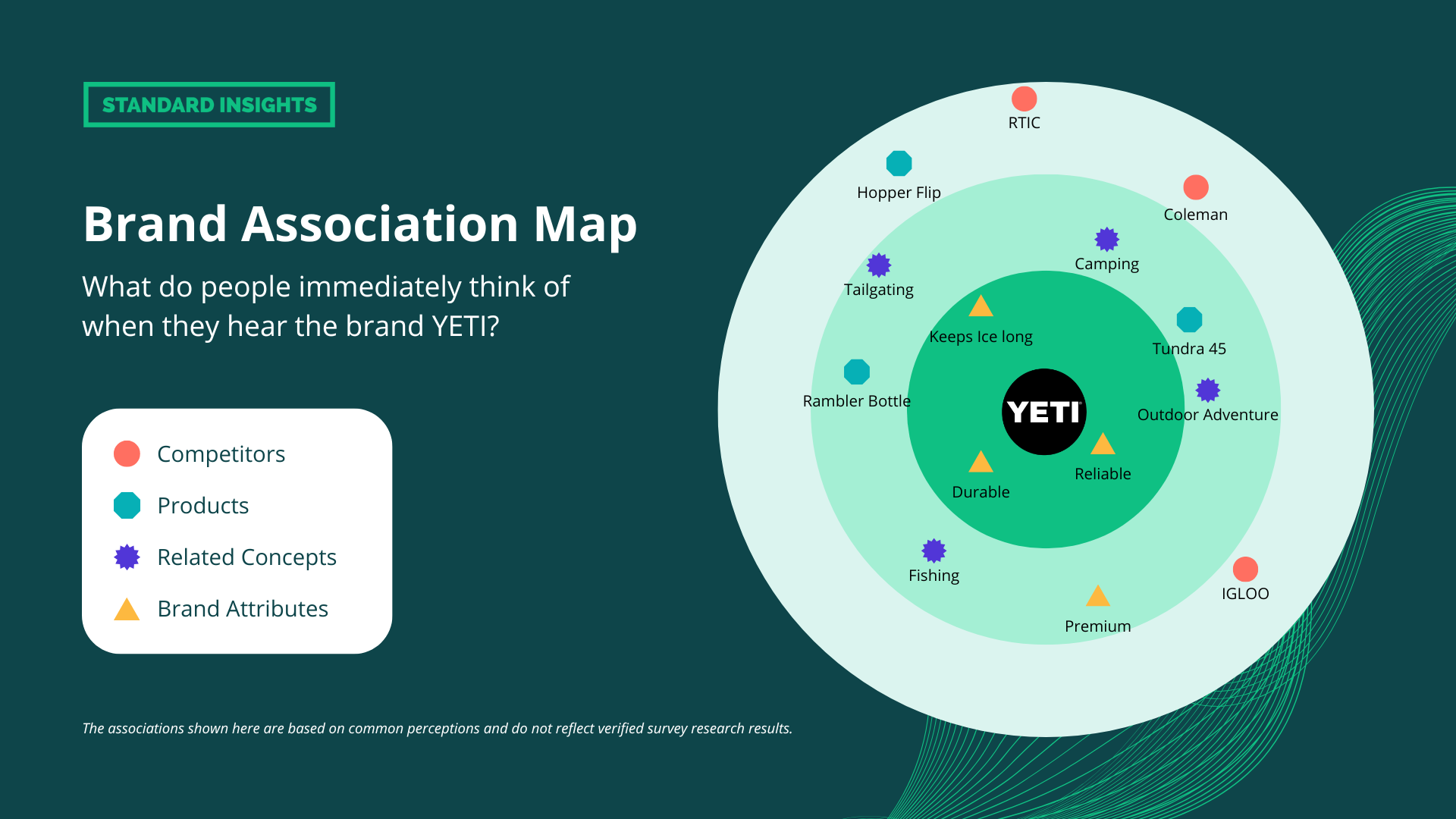
This kind of map makes it easy to spot your brand’s strengths, weaknesses, and new opportunities—all at a glance. The stronger—or more frequent—the association with your brand, the closer it will appear to your brand on the map.
👉 Create your own map with our Brand Association Map Generator
Step Three: Spot the Gap in Your Brand Associations and Close It
Now that you’ve compared your ideal brand associations with what people actually think, it’s time to spot the gaps. Where do the two misalign?
Maybe you want to be seen as “innovative,” but your audience sees you as “traditional.” Or perhaps you aim for “eco-friendly,” but customers aren’t aware of your efforts.
Once you know the disconnect, consider these proven strategies:
1. Anchor Your Desired Associations in a Strong Brand Strategy
Your brand strategy is the foundation of all associations. It ensures your brand’s identity comes through clearly and consistently at every customer touchpoint.
Without a clear strategy, customers form their own perceptions—ones that might be inaccurate, negative, or difficult to correct later.
Go back to the “Elements of Brand Association table” above.
Which elements—like your brand identity, messaging, customer experience, or partnerships—need the most attention to close the gaps you identified?
Focus on strengthening those areas.
Every touchpoint—logo, voice, service, storytelling, and more—should reinforce the associations you want to own.
Example: When Allbirds realized customers saw them as just “comfortable shoes,” not “sustainable,” they doubled down on eco-friendly messaging and carbon labeling to shift perceptions.
2. Take Advantage of Bold Partnerships
Sometimes the fastest way to build a strong brand association is through the right partner.
Partners can be influencers, ambassadors, creators, or even other brands—anyone who aligns with your values and embodies the associations you want to build.
When done right, partnerships can:
- Amplify your message
- Boost your visibility with the right audience
- Reinforce the traits and emotions you want to be known for
But, this only works if you are selective. Your partners are an extension of your brand.
Their reputation, values, and audience can either strengthen your brand associations or hurt them.
Look at Hoist, a hydration drink brand that has intentionally associated itself with the U.S. military. Hoist supports military foundations and programs, and is the official hydration partner of the U.S. military. This partnership goes to the core of their brand identity, reinforcing associations with endurance, reliability, and service. They even feature YETI bottles on their homepage. If you’re curious about how Hoist is standing out in the hydration market, don’t miss our complete case study on their unique brand strategy.
3. Tell Captivating Stories
People love a good story. It’s how we connect, spark memories, and make sense of the world.
So, what’s the story behind your brand? And are you sharing it?
You can talk about how your company got started, the challenges you’ve overcome, or the values that fuel your work.
Give people a peek behind the scenes—the real, human moments that show there’s more to your brand than just products and profits.
4. Ensure Consistent Brand Experiences
People feel more connected to brands when they know what to expect—whether they’re on your website, chatting with support, visiting your store, reading your emails, or scrolling through your Instagram.
Every interaction should feel like it’s part of the same story. Your tone, visuals, messaging, and service should all align and come from the same core.
Step 4: Monitor and Measure Your Brand Associations’ Progress
One of the best ways to know if your marketing is working is by tracking how it shapes brand associations.
Can you draw a line between a campaign, product launch, new tagline—or even an industry event—and changes in how people perceive your brand? If not, it’s time to start brand tracking.
Regularly checking how people view your brand brings two big advantages:
- Catch issues early – If sentiment dips or conversations shift, you can quickly adjust such as tweaking your messaging, or launching a new campaign.
- Spot and amplify wins – If customers start associating you with something powerful (like sustainability or innovation), you can lean in and amplify that connection.
How can you track brand associations?
- Social listening tools: Monitor online conversations, keywords, and sentiment on social media to see what associations pop up naturally.
- Review platforms: Pay attention to what people mention in their reviews—these often reveal authentic associations.
- Customer surveys: Regularly ask your customers directly what comes to mind when they think of your brand and how they’d describe it to a friend.
- Brand tracking solutions: Use specialized tools to measure your brand health and track changes in associations among your target audience, even if they’re not posting publicly.
Consistently measuring your brand associations gives you the clarity and confidence to make smarter marketing moves.
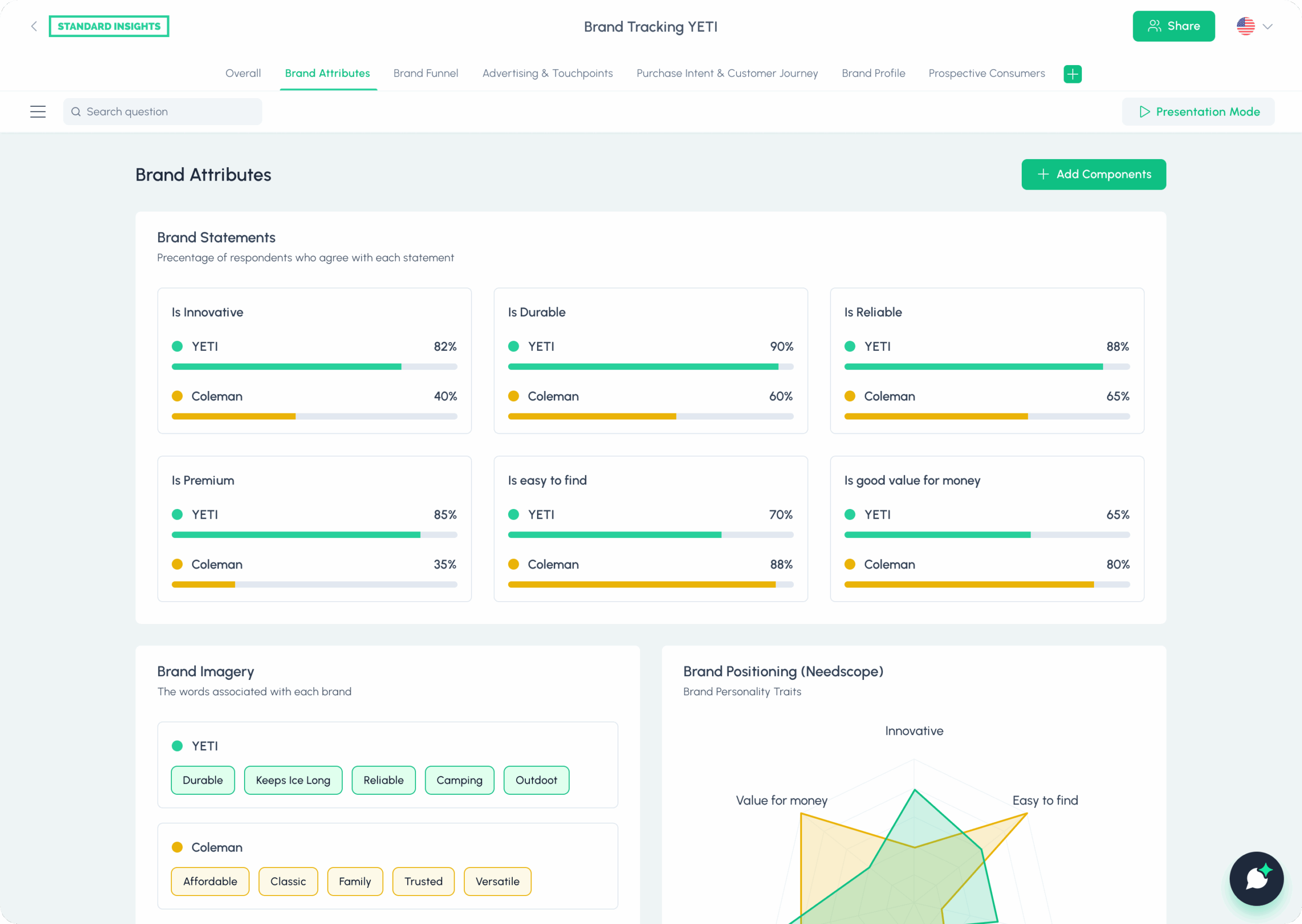
Brand association is just one of the 20+ metrics you get with our brand tracking survey solution.
If you want reliable feedback on your brand and your competitors—straight from real buyers, without spending months on setup—check out our brand tracking solution.
Make Brand Association Work for You
Brand association is the way people see your brand—often without even thinking about it. It can help you stand out, or hold you back.
If you don’t track it, you’re letting others shape your brand’s image for you. But with strong, positive associations, you’ll attract more loyal customers who are happy to pay more.
The secret?
Choose associations that match your values and what your ideal customers care about. Then, showcase them everywhere—just like Kiehl’s shop staff wear lab coats to signal expertise and quality.
Want to know what your brand really stands for—and how to take control?
Start tracking your brand associations, measure them, and keep improving.
Ready to see how you compare?
Check out our brand tracking solution for real feedback from real buyers—so you can build a brand people truly love.


